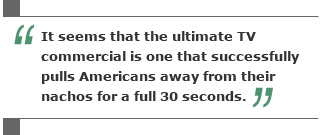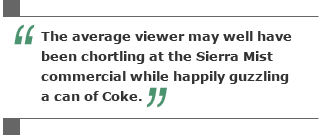On February 4, 90 million Americans were glued to their TV sets watching this year's great battle. But the contest that attracted a good many of these viewers wasn't the on-field tussle between the triumphant Indianapolis Colts and the Chicago Bears; nor was it the strategic toe-to-toe contest that pitted Tony Dungy against Lovie Smith. That's because the game was, for many of these TV watchers, a relatively minor sidelight. It wasn't about Peyton Manning's offense outmaneuvering Brian Urlacher's defense. And no, it wasn't about whether Prince was a better halftime choice than the Rolling Stones.
 |
For many of those watching Super Bowl XLI, the most riveting clash was between the companies that were each paying about $2.6 million to rent America's collective eyeballs for 30 seconds. In fact, The Gallup Poll noted that a third of those who were planning to watch the Super Bowl expected to be entertained more by the commercials than by the game. As in prior years, the Super Bowl excitement didn't just stem from running backs colliding with 300-pound defensive tackles. Rather, it was highlighted by the war between Coke and FedEx, Snickers and Sierra Mist, Chevy and Doritos -- and between Go Daddy and the network censors.
This fight has nothing to do with which of these advertisers did the best job presenting its brand message and its wares. Instead, the debate centers on which commercial was the most entertaining. It's all about amusing and impressing the viewers -- not to mention the advertising columnists -- with an emphasis far more on kindling belly laughs than on motivating purchases.
It seems that the ultimate TV commercial isn't one that causes Americans to change how they think, feel, or behave toward a brand. Rather, it's a TV spot that can cause a hush over a barroom crowd or one that successfully pulls Americans away from their nachos for a full 30 seconds.
 |
And so, as in Super Bowls past, leading marketers have turned to attention-getting celebrities, amusing animals, impressive special effects, catchy music, innovative animation, and breathtaking scenery -- and, of course, funny vignettes. They were spending millions in pursuit of stopping power, but that's not the same as selling power. (See "When the Stars Don't Shine" in the "See Also" area on this page.)
There's nothing wrong with entertaining an audience; Hollywood is built on it. But entertainment isn't the return that most company stockholders expect from a $2.6 million investment that's allegedly earmarked for brand building. Entertainment can enhance a compelling brand message, but it's not a substitute for one. As former Coca-Cola marketing leader Sergio Zyman stated, "Advertising that only entertains doesn't work." (See "Can Advertising Still Contribute?" and "Is Advertising Dead? (Part 1)" in the "See Also" area on this page.)
Entertaining without connecting
The business-building and brand-enhancing impact of these expensive Super Bowl messages can certainly be called into question. While many observers point to the brand-enhancing brilliance of Apple's famed "1984" Super Bowl XVIII launch of the Macintosh, there are precious few of these success stories.
Lots of ad messages aired during Super Bowl XLI, but it's not clear how many of them managed to do the job they were hired to do: credibly and compellingly connect with the viewers. Viewers may remember the celebrity, marvel at the visuals, or chuckle at the story. But how many can remember the name of the sponsoring brand? And how many feel any sort of personal connection with the message? And so, the average viewer may well have been chortling at the Sierra Mist commercial while happily guzzling a can of Coke, or chuckling at a Doritos ad while contentedly polishing off another plate of store-brand tortilla chips -- and genuinely puzzling over what a "Go Daddy" is or why on earth he might want one.
Of course, Super Bowl XLI is merely the latest and most vivid reminder of the need to enhance the brand, not just amuse the audience. Rex Briggs and Greg Stuart recently compiled an impressive amount of research in reaching their conclusion that 35%-40% of advertising is simply wasted money, achieving essentially nothing of substance. Given the emphasis on grabbing attention in a cluttered ad environment, it's likely that at least that much of Super Bowl XLI's advertising was wasted money -- and it was wasted at $2.6 million a pop. Maybe that's one reason why Unilever and Procter & Gamble, two of the world's largest and most respected advertisers, decided not to advertise in this year's Super Bowl. But while P&G waited on the sidelines, Garmin, Izod, and Salesgenie.com jumped right in to take their place.
 |
Interestingly, in 2007, the battle to entertain and amaze viewers moved into new arenas with new contenders. This year, the contest was waged by more than just ad agencies; it was also waged by consumers who were asked to submit their ideas regarding what it takes to woo an audience. It stands to reason. It's all part of a new emphasis on "consumer-generated content," and some marketers are apparently convinced that what works for YouTube must also work for Chevy, Doritos, and even the NFL. After all, maybe a breakthrough entertainment idea lies just around the corner -- even though it's unlikely that it's also a breakthrough selling idea.
So, if marketers aren't seeking to create credible and compelling brand messages that connect with the viewers, why not let anyone give it a whack? If marketers aren't trying to sell anything, they might as well just give everyone a shot at using their camcorders to create a message that's vivid or outlandish enough to interrupt viewers on their way to the kitchen.
The Super Bowl, however, is about winning on the field, and not just about entertaining the fans. That's why Tony Dungy and Lovie Smith didn't let the fans design and call the plays. Team owners demand a return on their investment, which is one reason for the merry-go-round of coaching changes that is part of each new season. "Just win, baby."
Brand owners should be just as demanding as football team owners, but it's not clear that they are -- at least when Super Bowl time rolls around. Perhaps some of them are confusing fun with work. And yet, company shareholders and brand stewards should require no less of a Super Bowl commercial than what they should require of any brand message they transmit.
Celebrities, catchy jingles, special effects, and funny stories aren't part of the requirements for an ad; they only make sense when they serve to support advertising's real job. It must be credible. It must be compelling. It must be capable of connecting with the brand's target audience. And it must yield a meaningful return, especially when it costs $2.6 million.